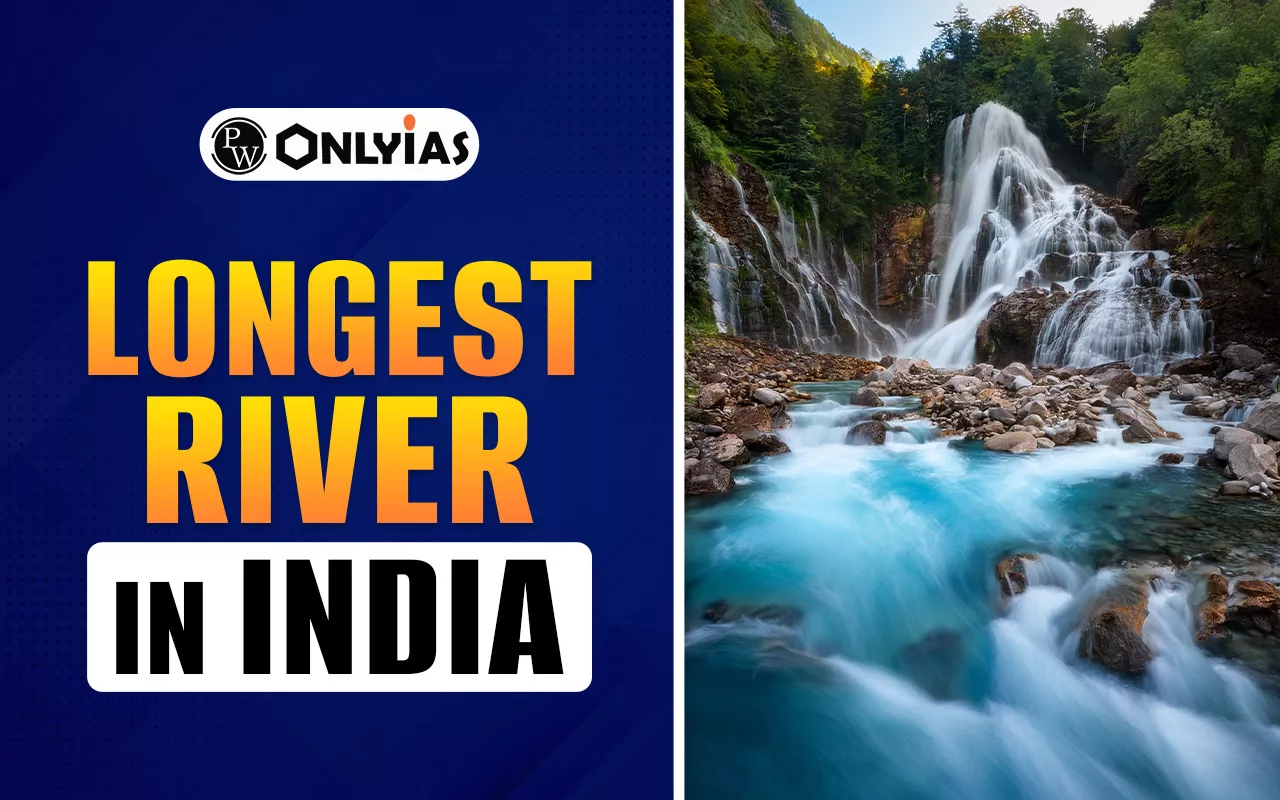The longest river in India is the Ganga, stretching 2,525 km from Uttarakhand to the Bay of Bengal. Other major rivers include Godavari, Krishna, Yamuna, Narmada, Brahmaputra, Mahanadi, Cauvery, and Tapi. Explore the top 10 longest rivers in India, their state-wise distribution, and the longest river in north, south, and North East India with a detailed rivers map of India.

India’s Longest River: The Ganga is the longest river in India, about 2,525 kilometres from the Himalayas to the Bay of Bengal. It’s not just long, it’s super important to people’s culture and beliefs. It starts way up in the Himalayas at the Gangotri Glacier in Uttarakhand. The Ganga goes through Uttarakhand, Uttar Pradesh, Bihar, Jharkhand, and West Bengal before emptying into the Bay of Bengal. Looking at a map shows where it goes and the areas it helps along the way.
India has tons of rivers that shape everything from the land to the culture and jobs. The Ganga is the longest, going over 2,525 kilometres from the Himalayas to the Bay of Bengal. Other big rivers like the Godavari, Krishna, and Brahmaputra are important for farming, travel, and daily life.
India has so many rivers! Some are long, some short, but they are all very important. This list of the longest rivers lets you know how they’re spread out all over the country. The Ganga is still the longest, but the Godavari and Krishna are big in the south, and the Brahmaputra is important in the northeast. Here are the top 10 with their length, where they start, and where they end up:
| Top 10 Longest Rivers in India | |||||
| S.No | River | Length in India (km) | Total Length (km) | Origin | Empties Into |
| 1 | Ganga | 2,525 | 2,525 | Gangotri Glacier, Uttarakhand | Bay of Bengal |
| 2 | Godavari | 1,464 | 1,465 | Trimbak, Maharashtra | Bay of Bengal |
| 3 | Krishna | 1,400 | 1,400 | Mahabaleshwar, Maharashtra | Bay of Bengal |
| 4 | Yamuna | 1,376 | 1,376 | Yamunotri Glacier, Uttarakhand | Confluence with Ganga |
| 5 | Narmada | 1,312 | 1,312 | Amarkantak Plateau, Madhya Pradesh | Arabian Sea |
| 6 | Indus | 1,114 | 3,180 | Tibet (near Lake Mansarovar) | Arabian Sea |
| 7 | Brahmaputra | 916 | 2,900 | Angsi Glacier, Tibet | Bay of Bengal |
| 8 | Mahanadi | 890 | 890 | Sihawa Hills, Chhattisgarh | Bay of Bengal |
| 9 | Cauvery | 800 | 800 | Brahmagiri Hills, Karnataka | Bay of Bengal |
| 10 | Tapi (Tapti) | 724 | 724 | Satpura Range, Madhya Pradesh | Arabian Sea |
North India has some important rivers. The Ganga is the longest. It runs over 2,525 kilometres, starting at the Gangotri Glacier in Uttarakhand and going through Uttar Pradesh, Bihar, and West Bengal. Lots of smaller rivers join it. On the left, the Ramganga, Garra, Gomti, Ghaghara, Gandak, Burhi Gandak, Koshi, and Mahananda flow into the Ganga. On the right, the Yamuna, Tamsa, Son, Punpun, Kiul, Karmanasa, and Chandan add to it.
The Ganga also helps a lot with farming in northern India, watering the fertile land in Uttar Pradesh and Bihar. Cities and towns along it get water, transport, and trade. It’s also really important for religious reasons and is a lifeline for millions of people.
Rivers in South India flow in a special curved pattern. The Godavari is the longest, at 1,464 kilometres. It starts near Trimbak in Maharashtra and goes through Chhattisgarh, Telangana, and Andhra Pradesh before emptying into the Bay of Bengal.
Many rivers join the Godavari. The Banganga, Kadva, Shivana, and Purna join on the left, while the Nasardi, Darna, and Pravara join on the right. The Godavari is important for watering crops, making electricity, and giving water to people in the southern states. It’s home to lots of different plants and animals and many people live near it, so it’s a super important river.
The Brahmaputra is the longest river in Northeast India. It’s 2,900 kilometres long in total, but 916 kilometres of it are in India. It starts at the Angsi Glacier in Tibet and enters India in Arunachal Pradesh.
The Dibang, Lohit, and Dhansiri rivers join it on the left, and the Kameng, Manas, Jaldhaka, Teesta, and Subansiri join on the right. In Assam, the Brahmaputra makes Majuli, a really famous river island. In Bangladesh, it’s called the Jamuna and joins the Ganges (Padma) before emptying into the Bay of Bengal.
A river map of India shows all the rivers across the country. They go all over, from mountains to plains to coasts. A map can show which way the rivers flow and where they start and end. For example, the Ganga flows east into the Bay of Bengal, but the Narmada and Tapi flow west into the Arabian Sea.
Looking at a river map is helpful for seeing where things are, where the rivers flow, and where the water is. It’s also helpful for seeing where farms, power plants, and transportation routes are. A map can help you learn about the longest river in India, its smaller rivers, and why they are important.
Check Out UPSC CSE Books
Visit PW Store
India has different states, and each one has big rivers that flow through it. Knowing the longest river in each state helps you see how important rivers are in each state. Here’s a list:
|
Longest River in India State Wise List |
|
| State/Union Territory |
Longest/Most Significant River |
| Andhra Pradesh | Godavari, Krishna |
| Assam | Brahmaputra |
| Bihar | Ganges, Kosi |
| Chhattisgarh | Mahanadi, Son |
| Gujarat | Narmada, Tapti (Tapi), Mahi |
| Himachal Pradesh | Chenab, Ravi, Sutlej (tributaries of Indus system) |
| Karnataka | Krishna, Kaveri |
| Madhya Pradesh | Narmada, Chambal |
| Maharashtra | Godavari, Krishna |
| Odisha | Mahanadi |
| Punjab | Sutlej, Ravi, Beas (tributaries of Indus system) |
| Rajasthan | Chambal, Banas |
| Tamil Nadu | Kaveri |
| Telangana | Godavari, Krishna |
| Uttar Pradesh | Ganges, Yamuna |
| Uttarakhand | Ganges (Bhagirathi and Alaknanda headwaters), Yamuna |
| West Bengal | Ganges (as Hooghly and Padma) |
| Kerala | Periyar |
| Goa | Mandovi (or Mahadayi) |
| Sikkim | Teesta |
| Jammu and Kashmir | Jhelum |
| Ladakh | Indus |
Ready to boost your UPSC 2026 preparation? Join PW’s UPSC online courses today!
The Ganga runs through Uttarakhand, Uttar Pradesh, Bihar, and West Bengal.
The Godavari goes through Maharashtra, Telangana, Andhra Pradesh, and Chhattisgarh.
The Brahmaputra enters India through Arunachal Pradesh and flows into Assam.
The one above shows the main rivers and where they go.
It's different for each one. For example, the Ganga in Uttar Pradesh, the Godavari in Andhra Pradesh, and the Brahmaputra in Assam.

<div class="new-fform">
</div>
